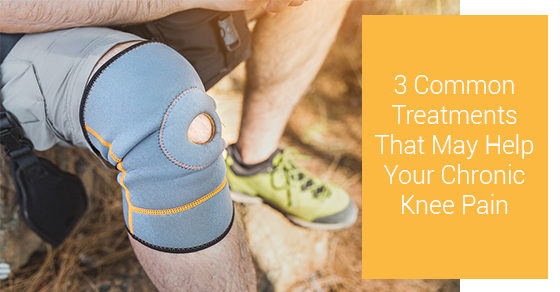The past 20 years have seen a 65% rise in the occurrence of chronic knee pain. 25% of adults suffer from knee discomfort, with 4 million doctor visits from patients seeking pain relief. Many people believe that pain comes is just a natural occurrence of life while others think ageing and pain go hand-in-hand. Continue reading for more information on your chronic knee pain treatment options.
Causes of Chronic Knee Pain
While sporting accidents are the number one cause of injured knees, merely stepping wrong can knock a knee out of commission. These can include skiing accidents, running, bicycling, as well as jumping during a sport or a workout.
Mechanical malfunctions also cause knee discomfort. If this doesn’t make sense, then try dislocating a knee. Another is loose chips of bone or cartilage broken off from degenerating bone or cartilage floats around the joint. It gets stuck in the joint, causing pain.
Lower back, hip, or foot pain will cause the body to compensate to spare itself pain. People tend to walk to one side like a ship listing to port. They walk gingerly to spare the injured side their body weight. This puts pressure on the knee which can be quite painful.
- Osteoarthritis comes with the degeneration of aging joints.
- Rheumatoid arthritis happens when the immune system turns against the joints.
- Gout is when uric acid crystals take up space in a joint. Pseudogout is when calcium crystals build up in the joint’s fluids.
- Septic arthritis happens when the joint has had no trauma but becomes infected. It is often accompanied by fever.
Risk Factors for Chronic Knee Discomfort
Prevention goes together with the risk factors for any problem. For example, knee discomfort is avoidable if the body is at its ideal weight. It is more likely that people who are obese will encounter knee problems from excess weight applying added pressure on the knees.
Strong muscles protect the bones and organs of the body. Make sure they are strong before playing a sport, or something like skiing. Likewise, make sure the body is flexible. A stiff body part is an invitation to injury.
Avoid placing adding stress on the knee. When exercising, do so in a pool or on a trampoline. Doing this three days a week lessens stress on the knee, allowing it to heal or prevent injury.
3 Chronic Knee Pain Treatments
Experts agree that anything is better than surgery. Thus, they agree on three options among a multitude of treatments: Exercise, medications, and orthotic devices.
Exercise
Physiotherapy concentrates on the muscles surrounding the knee. The hamstrings at the back of the thighs, the thigh muscles, quadriceps, plus the inner and outer adductors or the muscles at the sides of the thighs, all combine to make sure the knees are stable and working properly.
When the knees are injured, the muscles around them are tight. They are gathering their forces to prevent more injury to the knees. This puts more stress on the knees. The more stress, the more pain. These are a few of the exercises physiotherapy experts will prescribe:
- Sit on a couch or bed with the legs outstretched. Place a rolled-up towel or small pillow beneath the injured knee. Slowly lift the ankle until the leg is aligned with the hip. Count to ten. Repeat five times.
- Sit on a chair or the edge of a bed or couch. The legs should be bent at a 90-degree angle. Slowly lift the leg until it’s straight out in front of the body. Hold for a count of ten. Lower the leg, bending the knee. Repeat five times.
- Sit with the legs outstretched. Slowly bend forward, knees slightly bent to avoid injury. Place the hands on the ankles. Hold for a count of ten. The injured should feel the hamstrings stretch. Rise back up. Repeat five times.
- Stand with a hand on a chair or doorknob for balance. Slowly bend back the leg with the injured knee until the heel is against the buttocks. Hold the ankle with a hand. Hold for a count of ten. The injured should feel the quadriceps stretch. Slowly lower the leg. Repeat five times.
Medications
Massage is a highly recommended treatment for injured knees however, a massage may actually make things worse if pain is present. Thus, experts prefer prescribing non-steroidal anti-inflammatory drugs. Ibuprofen and acetaminophen are the most commonly prescribed. If they aren’t providing enough pain relief, your physician may prescribe a steroid with which to eliminate swelling and knee discomfort.
Injections of various types have become popular treatments recently. Corticosteroids remain the favorite of most doctors. One-shot treats the pain and inflammation for as much as six months.
In some cases, a doctor may prescribe muscle relaxers to help with knee discomfort. Some of them deaden the nerves relaying pain signals to the brain while relaxing the related muscles. Both take the stress off the knee, allowing its owner to get some rest.
Knee Braces
Compression sleeves are best for those who have arthritis. They re-distribute weight around the knee for a more comfortable workout or sporting event.
Wrap-around braces are ideal for those with mild knee discomfort or a dislocated knee. They provide all-around protection to make the day-to-day activity more comfortable while helping to distribute the weight and lessen the load on the knees.
Hinged and custom braces are handy for those needing support following surgery. These are for persons prone to landing on their legs the wrong way during a sport or workout.
For more information on Chronic Knee Pain treatment options or to get help fitting a knee brace, contact Focus Physiotherapy. Focus Physiotherapy has 6 convenient physiotherapy clinic locations in the Greater Toronto Area: Etobicoke, Mississauga, Brampton, Bolton, North York and York. Please click one of the locations below for contact information, directions and hours of operation. We look forward to speaking with you about chronic knee pain treatment.

